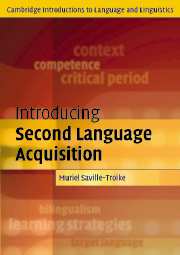Book contents
- Frontmatter
- Contents
- About the book
- Acknowledgments
- 1 Introducing Second Language Acquisition
- 2 Foundations of Second Language Acquisition
- 3 The linguistics of Second Language Acquisition
- 4 The psychology of Second Language Acquisition
- 5 Social contexts of Second Language Acquisition
- 6 Acquiring knowledge for L2 use
- 7 L2 learning and teaching
- Answer guide to questions for self-study
- Glossary
- References
- Index
5 - Social contexts of Second Language Acquisition
- Frontmatter
- Contents
- About the book
- Acknowledgments
- 1 Introducing Second Language Acquisition
- 2 Foundations of Second Language Acquisition
- 3 The linguistics of Second Language Acquisition
- 4 The psychology of Second Language Acquisition
- 5 Social contexts of Second Language Acquisition
- 6 Acquiring knowledge for L2 use
- 7 L2 learning and teaching
- Answer guide to questions for self-study
- Glossary
- References
- Index
Summary
CHAPTER PREVIEW
When we talk about what is being acquired in SLA, it is not enough just to talk about the language itself. We must also include the social and cultural knowledge embedded in the language being learned, that is required for appropriate language use. What must L2 learners know and be able to do in order to communicate effectively? Part of this knowledge involves different ways of categorizing objects and events and expressing experiences. But an important part involves learners understanding their own and others' roles as members of groups or communities with sociopolitical as well as linguistic bounds. What difference does group membership and identity make in regard to what is learned, how it is acquired, and why some learners are more successful than others? In this chapter, we focus attention on two levels of context that affect language learning: the microsocial and the macrosocial: The microsocial focus deals with the potential effects of different immediately surrounding circumstances, while the macrosocial focus relates SLA to broader cultural, political, and educational environments.
KEY TERMS
Communicative competence
Language community
Foreigner talk
Direct correction
Indirect correction
Interaction Hypothesis
Symbolic mediation
Interpersonal interaction
Zone of Proximal Development (ZPD)
Scaffolding
Intrapersonal interaction
Acculturation
Additive bilingualism
Subtractive Bilingualism
Communicative competence
From a social perspective, the notion of linguistic competence which was introduced in Chapter 1 is inadequate to account for what is being acquired in any language that is going to be used for communicative purposes.
- Type
- Chapter
- Information
- Introducing Second Language Acquisition , pp. 99 - 132Publisher: Cambridge University PressPrint publication year: 2005

